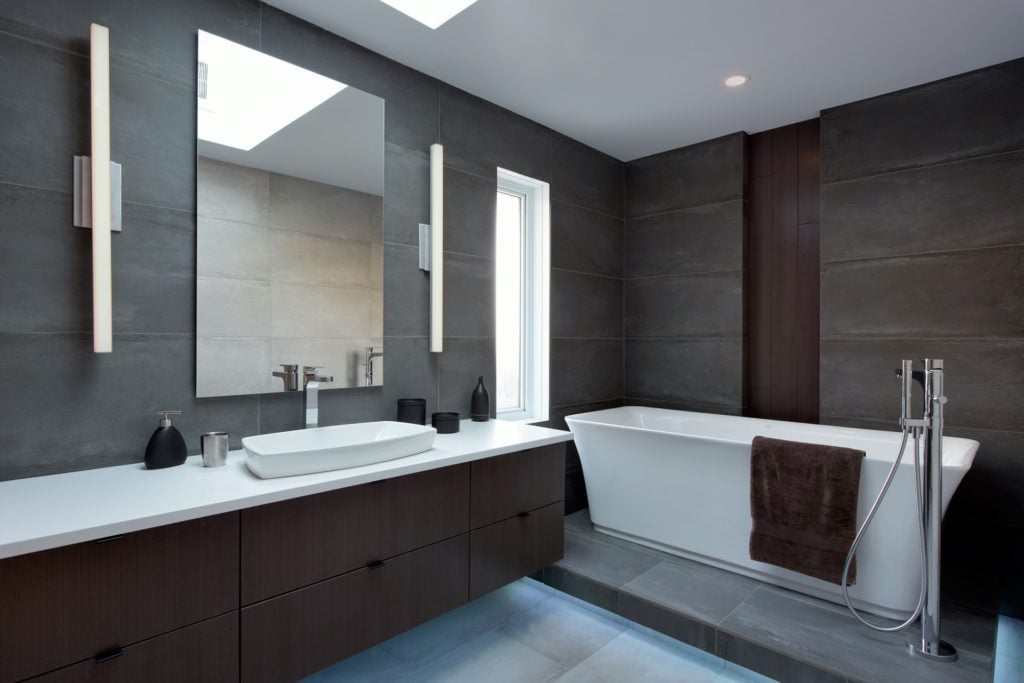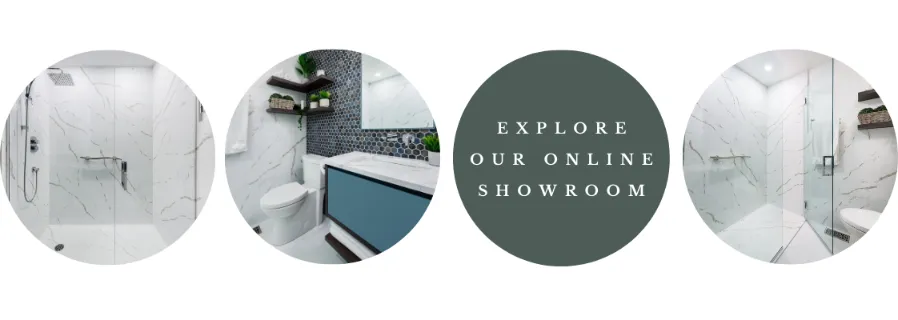12/09/2023 • Blog, How To, Design Tips, Bathroom
A Guide to Selecting the Ideal Bathtub for Your Bathroom Renovation
Estimated Read Time: 6 Minutes
Revamping your bathroom is a big task, but it can greatly enhance your home's appeal and value. A key focus of this makeover is selecting the right bathtub for your space.
Bathtubs lend as an anchor and focal point to the bathroom and can set the tone for the room itself.
Selecting the right type will ensure your room is functional for you and your family and beautifully coordinates with the aesthetic of your home, whether modern and minimalist, traditional or even coastal.
At Deslaurier Custom Cabinets, we pride ourselves on providing our clients with the knowledge and expertise to create the perfect designs. While we focus on functional and high-quality cabinetry, we know there is much more that goes into a successful bathroom project than just cabinets, which is why we’re here to help!
In this article, we will discuss all the essential considerations when selecting the ideal bathtub, from the size and layout of your room, the material you choose, installation, and plumbing.
|
Table of Contents |
|
Understanding Your Bathroom and Lifestyle |
Understanding Your Bathroom and Lifestyle
Before choosing a bathtub style or material, you'll want to consider a few factors about your bathroom itself and how the new tub will be used.
Step one is assessing the space available in your bathroom for a new tub. You may want to get something larger than you currently have or maybe stay the same size but replace it with something newer and more updated.
If you are also looking to change other features in the room, it can be a great idea to take a measuring tape and some painter's tape into the bathroom and give yourself a visual of how a tub, vanity, and other features will work in the space.
Marking space off on the floor can be tremendously helpful since the layout and design can significantly impact the flow and how user-friendly your bathroom is.
Your personal preferences, bathing habits, and household members' needs are important considerations. Think about how the tub will be used. It may be primarily for taking a relaxing bath or bathing children and pets. Ease of use for those in your family and yourself will affect the kind of tub you choose and other features you may want to add.
Types of Bathtubs
With all the options of bathtubs on the market, let’s go over some of the most common you will see in renovations today.
Freestanding bathtubs are both stylish and functional. Due to their design, they can be placed independently anywhere in the bathroom. This allows them to become beautiful focal points.
They are constructed with all sides that are finished and accessible, and the faucets are typically wall mounted or are freestanding units on the floor. You see these frequently with clawfoot and pedestal tubs meant for luxurious soaking.

Alcove bathtubs are sometimes called recessed bathtubs and are a very common installation in Canada and the U.S. This is because it is a space-saving design that worked well in many of the smaller homes built in the mid-20th century. Recessed into the wall, they are surrounded on three sides and typically are a combination shower and bath.
Drop-in bathtubs are ideal for building a custom tub deck with beautiful tile finishes. The tub sides are unfinished and customized with tiling or other finishes. These are more complex installations and better suited for a professional, not DIY, application.
Corner bathtubs are a great space maximizer. Typically separate from the shower in a bathroom, they usually only have one finished side facing out into the room, just as an alcove bathtub does. The facing front will range from rounded, angular, or even pentagon. These bathtubs are commonly placed in a corner with a window, allowing you to soak in the tub while enjoying a view.
Walk-in bathtubs are well-suited for homes with seniors or anyone who may have difficulty getting in and out of a standard tub. They have a door built into the tub wall, making getting in and out more accessible, and feature safety bars and many times, hydro jets.
These can be great for soothing aches and pains. They can be a tub alone or also a shower and tub combo. It is important to note that the one negative of these is that the tub must completely drain before the door is opened.
Oval tubs are known for making great soaking tubs. They are usually installed similarly to other freestanding tubs and can make a beautiful focal point in a bathroom.
They are typically deeper and many times longer than your average tub. This makes them the perfect choice for homeowners who love luxurious bubble baths or reading a book and enjoying a cocktail after a long week.
Materials and Finishes
When selecting the ideal bathtub for your renovation, the material and finish of your tub will be a very big decision.
Besides being functional for you or your family, you want your tub to be a stunning investment piece.
There are several materials and finishes to choose from. The six most commonly used and their benefits and drawbacks are below.
- Acrylic - Affordable and lightweight material that is easy to maintain.
- Cast Iron - Classic and sturdy. A heavier material that requires proper maintenance.
- Copper - Beautiful and unique material with natural antimicrobial properties.
- Fibreglass - Great budget-friendly option but not as durable as some other materials.
- Porcelain -enamelled Steel - Budget-friendly and durable material but can be prone to chipping.
- Stone Resin - Luxurious, high-end option that has excellent heat retention.
The material and finish you choose will depend on your budget, the look you are trying to achieve, and how your tub will be used daily.
Bathtub Sizes and Shapes
Standard bathtub sizes will vary based on the type of tub and its shape. Some of the most common shapes and their standard dimensions are:
- Alcove - 60" long, 32" wide, 18" deep
- Whirlpool - 60" long, 32" wide, 18-23 1⁄4 "deep
- Oval - 60" long, 41" wide, 24" deep
- Corner - 60" long, 60" wide, 22" deep
Custom-shaped bathtubs can vary widely as they are designed and manufactured to your unique specifications and dimensions. These can be oversized for large master bathrooms or small bathtubs if you are low on space.
All dimensions are essential based on the space your tub will be installed in but also for comfort and ease of access for those using the tub.
Depth is significant for safety and comfort if you have children or anyone elderly using the tub regularly. It is also a consideration if you bend or lean over the tub to wash pets or children regularly.
Budgeting and Cost Considerations
Depending on the materials, style and size of the bathtub you choose, prices can vary anywhere from $700 to $10,000.
Consulting with an expert in bathroom renovations will be the best way to keep an accurate budget for your project, including bathtub purchase and installation.
It is important to remember that hardware choices, bathtub faucets, and additional add-ons for comfort and safety will add to the total renovation cost.
If you are making significant investments in your renovation, leaving a buffer for unexpected expenses and additions to your budget is always a good idea. This will save you quite a lot of stress and headache.
Check out our article here to learn more about budgeting for custom bathroom vanities and renovations.
Installation and Plumbing
Just like electrical work, plumbing is one of those areas of home renovations that are usually best left to the professionals.
Just as electrical work done incorrectly has the potential for dangerous consequences, so can plumbing. If you are in the middle of a bathroom renovation and have a bathtub installed, it is always best to hire a professional.
A plumber will ensure that any new or existing plumbing lines are installed correctly and to code. Installers experienced in bathtub installation are key as well.
They know the steps to ensure the tub has been properly waterproofed and sealed. An incorrectly installed tub can lead to leakage that can damage floors and walls slowly or even more suddenly if something loosens or breaks that were improperly installed.
It is always a wise investment to have installations done professionally instead of paying costly repairs and replacements.
An important reminder for anyone taking on a structural bathroom renovation is that any structural renovation will require a permit under the Ontario Building Code Act.
Our cosmetic versus structural bathroom renovation article explains more about this requirement and is incredibly helpful.
Design with Deslaurier Custom Cabinets
When selecting the right bathtub for your bathroom renovation, it is essential to consider all the points above, including material, type of tub, cost, and installation.
Choosing a tub that fits your lifestyle and aesthetic means you'll have a gorgeous bathroom for years to come.
If you’re thinking about starting a bathroom renovation and need expert help, Deslaurier Custom Cabinets has everything you need from bathroom vanities to customized storage.
With over 40 years of experience to our name and an outreach of over 30 dealers across Ontario, we provide our clients with a fully customized design process with our talented team of designers.
Book a free consultation with a Deslaurier design expert at our Ottawa showroom!
Live outside the area? Find a Dealer to connect with near you! Interested in becoming an authorized Deslaurier dealer? Visit our Become a Dealer page to learn more!
.png?width=224&height=80&name=Final%20(3).png)


